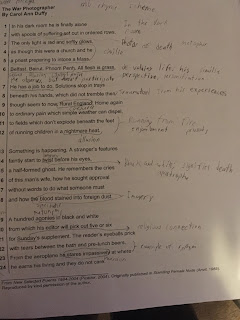Poetic Notes
Daniel Arcega
Mrs. Emerick
IB English HL II
Poetic Notes
Poem #1: "The War Photographer" by Carol Anne Duffy
- Duffy juxtaposes gruesome imagery with the photographer's perspective to illustrate how one is able to become desensitized to violence through constant witnessing of it.
- Duffy uses violent imagery to convey the horrors witnessed by the photographer.
- "fields which don't explode beneath the feet of running children in a nightmare heat"(11-12)
- "blood stained into foreign dust"(18)
- These lines show the reader what the photographer sees everyday
- The strong visuals help to align the reader's perspective with that of the photographer.
- The photographer's mannerisms are shown in contrast to the horrid events he sees.
- "Solutions slop in trays beneath his hands, which did not tremble then though seem to now"(7-8).
- In the moment of witnessing the violence, the photographer had no distinct reaction to it, shown by his hands not shaking.
- "From the aeroplane he stares impassively at where he earns his living and they do not care"(23-24).
- The photographer views the horrors of war as nothing more than his job.
- "he stares impassively" implies that he does not invest emotion into the ongoing tragedies.
- Duffy uses the photographer's muted reactions to the horrid imagery of war to demonstrate a person who has become numb to violence.
- The poem illustrates the terribleness that the photographer witnesses.
- Over time, the violence slowly loses its effects over him.
- Eventually, he gets used to the gruesome images. He stops finding horror and disgust in them
- He no longer feels compelled to react to such images anymore.
Connection:
This poem has a potential connection to The Things They Carried by Tim O'Brien. The two works connect in the way they portray a character dazed by war. In the first chapter, Kiowa feels distraught at not feeling any strong emotions when his comrade dies. He faces a similar crisis to the photographer, who has little reactions to the horrors surrounding him. Both have witnessed war for so long that they are numb to the pain and suffering around them.
Poem #2: "Originally" by Carol Anne Duffy
Connection: One potential connection that this poem has is with Monkey Bridge by Lan Cao. Both the poem and the novel focus on a character who moved away from their original country and was thrust into an unfamiliar situation. The works illustrate their rapidly changing surroundings and the effects they have on them. Thanh in Monkey Bridge struggles to properly adapt to her new life in America. The narrator in "Originally" is overwhelmed by the transition and cannot properly comprehend her situation. Both are troubled by their new surroundings.
- Duffy portrays maturing in a negative light to convey the disparity between the reality of a child and of an adult.
- In the first half of the poem, Duffy uses youthful word choices and imagery.
- "The laugh of a bell swung by a running child"(8)
- A cheerful image
- Invokes a sense of delight and innocence
- "The classroom glowed like a sweet shop. Sugar paper. Colored shapes"(10-11).
- Invokes images of joy and sweetness.
- Also connects to the saying, "like a kid in a candy store"
- As the poem progresses, Duffy's writing becomes more mature.
- "Bradley and Hindley faded, like the faint uneasy smudge of a mistake"(11-12).
- The first mention of a more mature subject; symbolizes the shift in tone
- "A rough boy told you how you were born"(21-22).
- A very mature subject
- Learning about reproduction often connected to the loss of innocence.
- Duffy portrays the events of the poem much differently in the innocent and mature sections.
- "Mrs. Tilscher loved you. Some mornings, you found she's left a good gold star by your name"(13-14).
- Instills a feeling of comfort, joy, and excitement
- The narrator believes Mrs. Tilscher cares about her
- The gold star is portrayed as an object of simple gratification
- "You asked her how you were born and Mrs. Tilscher smiled, then turned away. Reports were handed out"(26-28).
- Happens after the narrator has matured a little
- The mentioning of report cards feels stale and unexciting
- Indicates that Mrs. Tilscher does not care for the students all that much
- The difference between these two events illustrates the difference in perspective between the innocent and mature
- Painting growing up as negative suggests that the child's view of reality is pure
- As the narrator matures, the tone matures as well
- The end of the poem is much less wonderous and clean
- By the end, the narrator is rushing to grow up, going straight into a storm
Connection:
One potential connection this poem has is with My Brilliant Friend by Elena Ferrente. Both works depict a child going through a period of change. As they mature, they begin to perceive more about the world and themselves. In My Brilliant Friend, the main character Lenu learns more about her body and the way her community works. The narrator in "Mrs. Tilcher's Class" begins to understand how her world isn't as she perceived it to be Their new perceptions reveal a much bleaker life than they originally thought.





Comments
Post a Comment